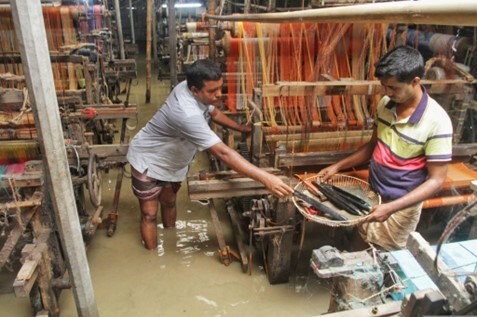
Image by uweseidner/Adobe Stock
The Aral Sea, lying between Kazakhstan to its north and Uzbekistan to its south, was once the world’s fourth-largest inland sea. It has now dramatically shrunk (90% between the 1950s and 2009) due to extensive water diversion for irrigation and hydropower. The reckless usage of the sea has brought severe environmental and socio-economic consequences for all the surrounding countries. The effects of climate change compound this ongoing catastrophe. Adaptation is essential.
The United Nations Economic and Social Commission for Asia and the Pacific (ESCAP) has conducted comprehensive assessments to understand the impacts and risks of climate change in the region. In line with the UN Sustainable Development Goals, these efforts aim to guide adaptation measures, ensuring sustainable livelihoods and environmental recovery in the Aral Sea region.
Issue
The Aral Sea region faces critical issues, including significant loss of water (desiccation), increased salinity, and the collapse of local ecosystems. These changes have drastically affected livelihoods in the area, leading to economic hardships and health problems due to the now-arid climate and dust storms carrying pollutants.
The primary challenge is reversing the environmental degradation while addressing the affected communities’ immediate needs. The region’s complex socio-political landscape and the need for transboundary water management cooperation further complicate efforts. Moreover, climate change is expected to exacerbate the frequency and intensity of droughts and other climate hazards, further straining the fragile ecosystem.
Solution
ESCAP recommends a multifaceted approach to adaptation, including improving water management practices, rehabilitating affected ecosystems, putting in place multi-hazard early warnings and promoting alternative livelihoods. Key strategies involve enhancing regional cooperation to accelerate adaptation and resilience pathways of climate action including through sustainable water use, implementing advanced agricultural techniques to reduce water consumption, and investing in renewable energy sources to mitigate climate change impacts.

Figure: The shrinking of Aral Sea through satellite imagery
Source: ESCAP, Managing in-land water disasters in the Aral Sea : sub-regional pathways for adaptation and resilience. (2022)
Details
The Aral Sea was once the world’s fourth-largest lake. But it has undergone dramatic shrinkage, or desiccation – some by 90% since the 1960s. This outcome is mainly due to the diversion of its inflowing rivers for agricultural irrigation and is now compounded by the higher temperatures, droughts, and other climate change-related effects.
This ecological catastrophe has not only altered the landscape but also devastated the local climate, biodiversity, and the livelihoods of people living in the vicinity – some 51 million people in the basins around the Aral Sea, including those from Uzbekistan (55%), Tajikistan (16%), Kyrgyzstan (10%), Turkmenistan (10%), and Kazakhstan (9%).

Figure: Map of the population surrounding the Aral Sea
Source: ESCAP, Climate change impact scenarios in the Aral Sea
The region, which once thrived on fishing and related industries, now grapples with economic hardship and health problems such as respiratory and digestive issues, low birthrates, cancer from inhaling and ingesting the blowing salt and dust, and poorer diets.
Addressing the catastrophe
In response to this crisis, the United Nations Economic and Social Commission for Asia and the Pacific (ESCAP) has done comprehensive assessments to understand the impact of climate change on the Aral Sea and its surrounding regions (detailed report here). ESCAP’s work focuses on identifying sustainable adaptation strategies for mitigating the adverse effects of the sea’s shrinkage. Through collaborative efforts with local governments and international partners, ESCAP is further mandated through a resolution to study the modalities for the establishment of the United Nations special programme for the Aral Sea basin. This is essentially to restore the area’s ecological balance, improve water resource management, and support the affected communities in transitioning to sustainable livelihoods.
The affected communities, in the Aral Sea basin, have seen their way of life fundamentally changed by the sea’s decline. ESCAP’s recommendations for adaptation measures are designed to revitalize the region by ensuring access to climate risk information and early warnings, clean water, restoring damaged ecosystems, and promoting economic resilience among the local populations.
Seeking solutions
The ESCAP implementation process for addressing the challenges of the Aral Sea is comprehensive, involving many stakeholders. These include national governments of Central Asian countries, including Kazakhstan, Uzbekistan, Kyrgyzstan, Tajikistan, and Turkmenistan, international organizations, and local communities affected by the Aral Sea’s desiccation.
ESCAP’s methodology for assessing impacts and identifying risks combines advanced climate modeling, risk assessment techniques, and stakeholder consultations in pursuit of a nuanced understanding of the situation. Through expert consultations and regional meetings, ESCAP facilitated a platform for exchange, aiming to foster regional cooperation and develop a unified strategy for mitigation and adaptation.
ESCAP’s analytical studies used a multidisciplinary approach to understand the crisis’ socio-economic and environmental dimensions. By downscaling climate models and incorporating geographical and hydrological data, ESCAP aimed to predict future scenarios and assess their potential impacts on the region’s sustainability. The studies focused on identifying critical areas of vulnerability and proposing targeted adaptation measures to address the risks associated with climate change and water mismanagement.
For instance, the work found women and children were the most vulnerable groups in Central Asia. It found maternal and infant morbidity and mortality were substantially higher in the Karakalpakstan (Uzbekistan) and Kyzylorda (Kazakhstan) regions. This discouraging finding may be due to factors such as resource pollution and environmental factors such as pesticides and high levels of water mineralization.

Figure: Hotspots of low Human Development Index and land degradation
Source: ESCAP, Managing in-land water disasters in the Aral Sea : sub-regional pathways for adaptation and resilience. (2022)
A survey of “hotspots” found vulnerable populations with a low to medium Human Development Index (HDI). These were mainly in Kyrgyzstan, Tajikistan, southern Uzbekistan, and central and southwestern Turkmenistan.
Outcomes and implementation
ESCAP’s recommendations for adaptation focus on enhancing resilience across several key areas. Strategies include strengthening multi-hazard risk assessment and early warning systems, improving dryland agriculture crop production, and making water resources management more resilient. These adaptation measures are designed to address the complex interplay of climate change impacts, aiming to restore ecosystems and provide sustainable livelihoods for the affected communities.
The outcomes of ESCAP’s implementation process aim to build a framework for sustainable development and disaster risk reduction in the Aral Sea region. Recommendations from these studies advocate for integrated water resource management, restoring ecosystems, and promoting alternative livelihoods for affected populations. By aligning these strategies with the Sustainable Development Goals (SDGs), ESCAP seeks to address the broader challenges of poverty, health, and environmental degradation exacerbated by the Aral Sea’s decline.
These initiatives are vital for the long-term health of the region’s environment and people. In doing so, they particularly address SDG 13 (Climate Action), 14 (Life Below Water), and 15 (Life on Land). There are five key adaptation strategies, including a multi-hazard risk assessment and early warning system for mitigating cropland exposure to multiple hazards, especially drought and flood. Early warning monitoring is also needed for planning and reducing multi-hazard impacts on people

Figure: Climate adaptation priorities matric for the Aral Sea vis-à-vis cluster of SDGs
Source: ESCAP, Managing in-land water disasters in the Aral Sea : sub-regional pathways for adaptation and resilience. (2022)
The focus on capacity building and policy dialogue shows the need for continuous engagement and adaptation to evolving environmental and socio-economic conditions. Ultimately, ESCAP’s efforts aim to achieve resilience and sustainability for the Aral Sea basin. Regional cooperation and informed policymaking are vital in overcoming transboundary environmental crises.
The focus on capacity building and policy dialogue shows the need for continuous engagement and adaptation to evolving environmental and socio-economic conditions. Ultimately, ESCAP’s efforts aim to achieve resilience and sustainability for the Aral Sea basin. Regional cooperation and informed policymaking are vital in overcoming transboundary environmental crises.
Overall recommendations from ESCAP include (source):
- Developing a regional water policy for balanced use and improved ecology.
- Developing new ways of cooperating in transboundary river basins, mainly based on countries’ economic integration
- Accelerating reconstruction of water management infrastructure, saving water and reducing wastewater
- Promoting the cultivation of drought-resistant crop varieties
- Introducing green and low-water usage technologies, water recycling systems, and developing new wastewater treatment technologies
- Improving regional hydrometeorological services’ accuracy and efficiency for climate change adaptation and disaster risk management
- Organizing an expert network on the ESCAP platform to strengthen regional cooperation and attract investment for Aral Sea projects
The ESCAP reports lay the groundwork for targeted, effective adaptation initiatives. The emphasis on sub-regional cooperation and transboundary water management comprehensively aims to ward off the Aral Sea catastrophe’s broad impacts. These efforts can help work toward a sustainable future for Central Asia, facing the realities and pragmatically adapting.
ACKNOWLEDGEMENTS
We extend our appreciation to the United Nations Economic and Social Commission for Asia and the Pacific (ESCAP) for their generous provision of this case study to the database.
Related Information
KEYWORDS
- # Case Study
- # Agriculture
- # Biodiversity/Ecosystem
- # Human Health
- # Life of Citizenry and Urban Life
- # Local Communities
- # Natural Disasters
- # Water Environment/Water Resources
- # Adaptation Action/implementation
- # Adaptation Planning/Policy
- # Climate Projection
- # Disaster Prevention/Disaster Mitigation
- # Education/Awareness/Information
- # Impact Assessment/Risk Assessment
- # International Cooperation
- # Research/Innovation
- # Asia
- # Kazakhstan
- # Uzbekistan




